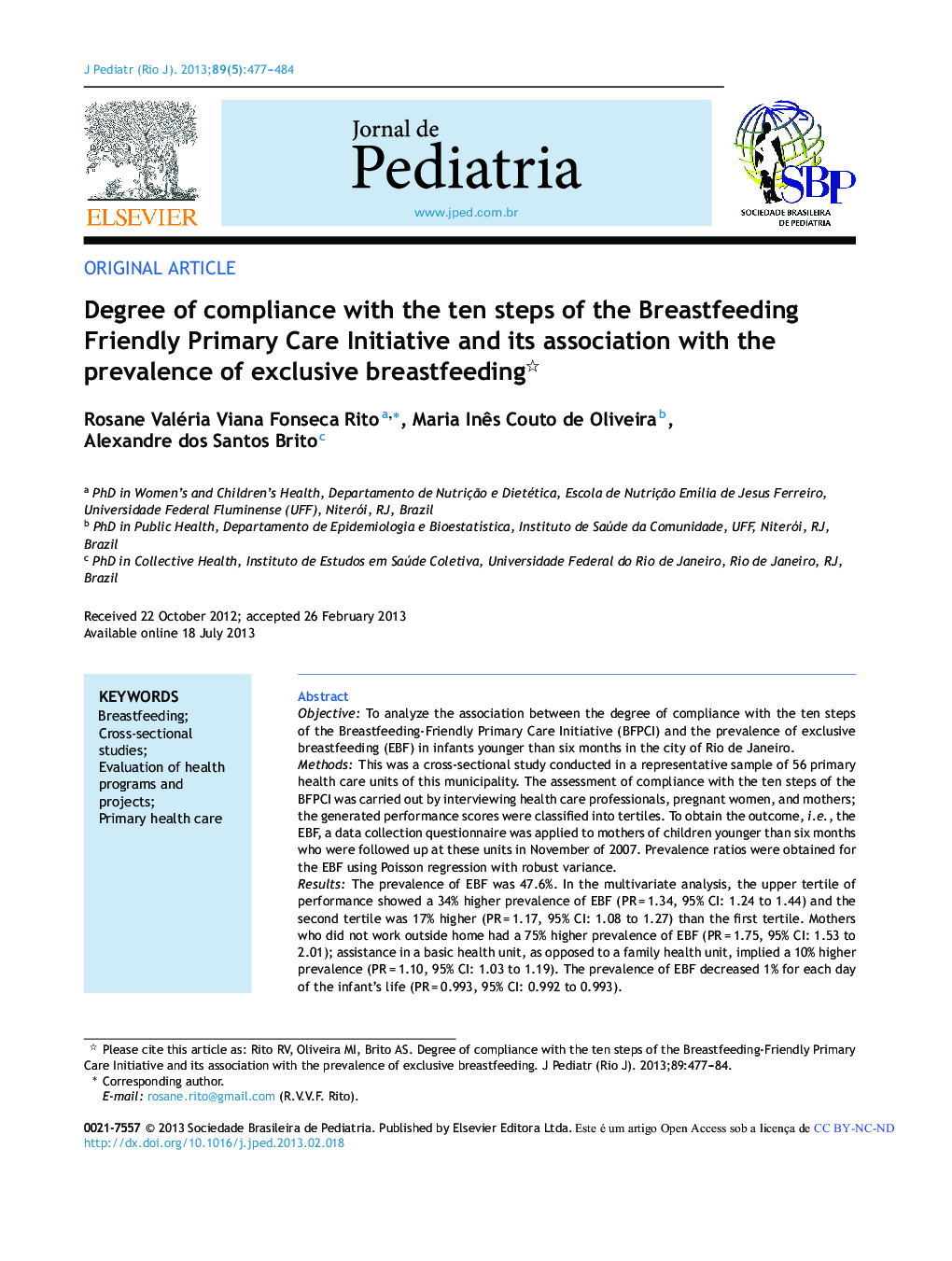| Article ID | Journal | Published Year | Pages | File Type |
|---|---|---|---|---|
| 4154025 | Jornal de Pediatria | 2013 | 8 Pages |
ObjectiveTo analyze the association between the degree of compliance with the ten steps of the Breastfeeding-Friendly Primary Care Initiative (BFPCI) and the prevalence of exclusive breastfeeding (EBF) in infants younger than six months in the city of Rio de Janeiro.MethodsThis was a cross-sectional study conducted in a representative sample of 56 primary health care units of this municipality. The assessment of compliance with the ten steps of the BFPCI was carried out by interviewing health care professionals, pregnant women, and mothers; the generated performance scores were classified into tertiles. To obtain the outcome, i.e., the EBF, a data collection questionnaire was applied to mothers of children younger than six months who were followed up at these units in November of 2007. Prevalence ratios were obtained for the EBF using Poisson regression with robust variance.ResultsThe prevalence of EBF was 47.6%. In the multivariate analysis, the upper tertile of performance showed a 34% higher prevalence of EBF (PR = 1.34, 95% CI: 1.24 to 1.44) and the second tertile was 17% higher (PR = 1.17, 95% CI: 1.08 to 1.27) than the first tertile. Mothers who did not work outside home had a 75% higher prevalence of EBF (PR = 1.75, 95% CI: 1.53 to 2.01); assistance in a basic health unit, as opposed to a family health unit, implied a 10% higher prevalence (PR = 1.10, 95% CI: 1.03 to 1.19). The prevalence of EBF decreased 1% for each day of the infant's life (PR = 0.993, 95% CI: 0.992 to 0.993).ConclusionGiven the contribution of BFPCI to the practice of EBF, a greater investment in the expansion and sustainability of this initiative is recommended, as well as its association with other strategies to promote, protect, and support breastfeeding.
ResumoObjetivoAnalisar a associação entre o grau de cumprimento dos Dez Passos da Iniciativa Unidade Básica Amiga da Amamentação (IUBAAM) e a prevalência de aleitamento materno exclusivo (AME) em menores de seis meses no município do Rio de Janeiro.MétodosEstudo transversal conduzido em amostra representativa de 56 unidades básicas de saúde deste município. A avaliação do grau de cumprimento dos Dez Passos da IUBAAM foi realizada por entrevista a profissionais, gestantes e mães, e os escores de desempenho gerados foram classificados em tercis. Para obtenção do desfecho, o AME, foi aplicado formulário de coleta de dados às mães de crianças menores de seis meses que demandaram estas unidades em novembro de 2007. Foram obtidas razões de prevalência do AME por regressão de Poisson com variância robusta.ResultadosA prevalência de AME foi de 47,6%. Na análise multivariada, o tercil superior de desempenho apresentou uma prevalência de AME 34% maior (RP = 1,34; IC95% 1,24-1,44), e o segundo tercil, 17% maior (RP = 1,17; IC95% 1,08-1,27) que o inferior. A mãe não trabalhar fora gerou uma prevalência de AME superior em 75% (RP = 1,75; IC95% 1,53-2,01), e a assistência em unidade básica de saúde, em contraposição à saúde da família, em 10% (RP = 1,10; IC95% 1,03-1,19). A prevalência de AME caiu 1% a cada dia a mais do bebê (RP = 0,993; IC95%: 0,992-0,993).ConclusãoDiante da contribuição da IUBAAM à prática do AME, recomenda-se maior investimento na expansão e sustentabilidade desta iniciativa, bem como sua articulação com outras estratégias de promoção, proteção e apoio à amamentação.
